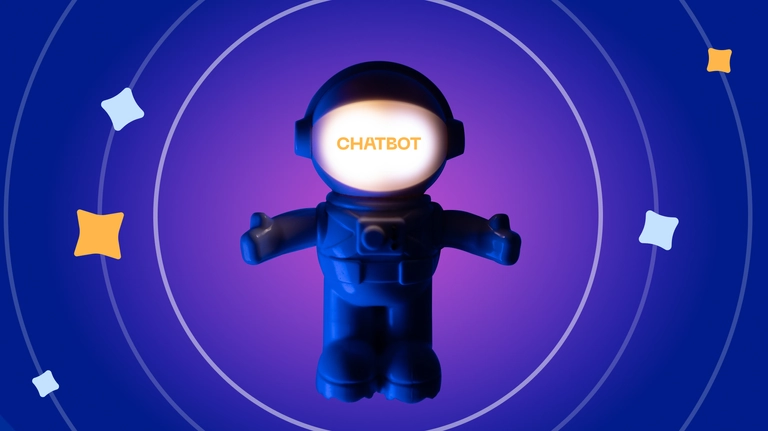
10 successful chatbot examples used by businesses to boost conversions
Want to boost conversions and reduce your workload at the same time? Here’s how 10 brands achieved this using automated chatbots.
Does a chatbot sound too futuristic for your business? Then let’s get realistic.
A report by NotifyVisitors revealed that 70% of online shoppers pick a chatbot over a human agent if it cuts down their waiting time.
Businesses like yours, companies that you look up to, and even the brands you personally shop from are using chatbots to boost their conversions and customer engagement as you read this.
So the future is already here.

What is a chatbot?
A chatbot is a software application that simulates human conversation, processes instant responses to customer requestsand incoming messages, collects customer feedback, and improves customer satisfaction. Whether customers want to book an appointment, download a guide, or buy a product, the chatbot guides them through the following steps.
It can handle any volume of queries and respond instantly at any time of day, even outside of business hours. This capability makes chatbots an invaluable tool for businesses looking to improve customer service and operational efficiency.
In this article, we’ll be sharing 10 successful chatbot examples used by businesses that took their conversions to the next level.
KLM Royal Dutch Airlines | Facebook

KLM’s customers spent a lot of time on their Facebook Page, but it’s not a place that allows them to share sensitive travel information.
So KLM decided to opt for a Messenger chatbot and updated their Page with a Send Message button. This allowed customers to seamlessly and safely exchange their travel and contact details.
Within a few months, KLM’s Messenger comprehensive automation got higher satisfaction scores compared to any other of their channels for communication with customers.
How? By turning it into a travel agent you can carry in your pocket that can assist you in every phase of your journey.
You can check ticket prices, get booking confirmations, check-in and flight status updates, and receive your boarding passes through the chatbot, all in real time.
Results:
+40% customer interactions,
15% of boarding passes sent automatically.
KLM’s Messenger chatbot.
Art’Fact | Instagram
💡Chatbot built with Chatfuel

Beauty brand Art&Fact’s Instagram account was attracting a huge volume of messages with customer queries about which products are ideal for their skin. So they tried to run a basic test promo: 100 video consultations on Zoom, 30 minutes each.
When their two-week-long attempt to launch this promo didn’t work out, they tried to launch it with the help of advanced automation this time.
Potential customers who expressed interest got automated messages with friendly reminders to complete a survey and book a Zoom meeting with a skincare professional through Calendly.
Guess how long it took to set up this Instagram chatbot? Only 40 minutes.
Results:
Outreach and engagement rate raise: +100 applications within 2 hours,
86% conversion rate,
200 users got a discount code.
Read the full customer story here.
Domino pizza | Tinder

Domino’s has been using a chatbot for customer communication and auto-reply messages on its website for a long time. However, they have not been able to popularize this process through social messaging channels yet.
So they decided to debut their first-ever dating bot, Dom Juan, during Valentine's season. They teamed up with Tinder users to give them pun-packed cheesy pick-up lines and funny GIFs for higher engagement rates and a friendly tone.
This off-beat approach to target the festive season and show their brand personality in a unique light made Dom Juan go viral overnight.
Results:
35x ROAS (return on advertising spend),
+10% sales compared to the previous year.
CodEye | Facebook
💡Chatbot built with Chatfuel

Media company CodEye Technologies had a well-designed app and a popular following. But they were struggling to engage readers and were getting merely 20-30 app installs for every $100 they invested in Facebook ads.
So their content creators decided to use a Messenger chatbot on their website to push targeted content and promote a gaming referral program.
They could also build lookalike audiences to direct the most relevant ads and content to each reader.
Results:
194% ROI (return on investment),
$0 CPA (cost per acquisition),
90% of FAQs automated,
+30% organic engagement,
+40% app installs per month,
Read the full customer story here.
Mindvalley | Instagram

For educational tech company Mindvalley, masterclass signups are its biggest success metric since they bring in most of the company’s revenue. They depended on swipe-up Stories and links in bio to promote their masterclasses and educational content.
But they weren’t hitting the lead generation and retention rate targets they aimed for.
So they decided to innovate their digital communication with an Instagram chatbot to provide more personalized communication and timely responses.
People could now type a specific word and be directed to a relevant masterclass on that topic. They were given the option to sign up or read a quick summary of the takeaways from each class in follow-up messages.
Results:
+ 522% masterclass signups,
99% reduce in Instagram response time.
Lego | Facebook
💡Chatbot built with Chatfuel

Lego has to walk a fine line when it comes to its brand voice, as they have to appeal to both the kids and their parents buying the products.
However, most adults are not familiar with the new line-up of Lego sets, which led to long consultations with human agents or made them drop the idea of buying it.
They decided to launch a Facebook Messenger chatbot called Ralph to solve this problem. The chatbot conversation begins with a friendly greeting and dynamic buttons to determine their child’s tastes and needs, which presents them with the best options.
Results:
25% of social media sales automated,
CPC (cost-per-conversion) is 31% lower than Facebook Ads.
3D Mats | Website
💡Chatbot built with Chatfuel

There were three big problems holding the productivity of 3D Mats business communications:
A customer service team overburdened by the simple common inquiries of website visitors leading to longer response times.
No clear idea of their target audience, which made it difficult for content creators to make their content relevant.
Poor conversions from their Facebook ads.
The team realized how all these problems were connected and used a chatbot builder to create their own comprehensive solution.
They used auto-reply feature, triggered when customer inputs contained a specific keyword to answer any FAQs. People could also take a quiz to get better product recommendations for their cars. This helped them reduce their repetitive inquiries by 70%, save valuable time, maintain personalized communication, and improve customer experience.
Thanks to the updated customer base with data gathered by their chatbot, the digital marketers of 3D Mats optimized their Facebook ad performance and communication with customers.
Results:
999% return on ad spend (ROAS,
70% of repetitive customer inquiries are automated,
47% of customers purchase recommended products,
30% repurchase rate.
Read the full customer story here.
Ultima.school | WhatsApp
💡Chatbot built with Chatfuel

Ultima.school, a Brazilian online educational platform, partnered with Chatfuel to use a ChatGPT WhatsApp chatbot. Powered by AI (artificial intelligence), this solution successfully decreased customer acquisition costs by half while maintaining the same conversion rate.
Additionally, they now use re-engagement messages to promote offers and boost retention rates and sales.
Results:
2x less CAC (customer acquisition costs),
Same end-to-end conversion to purchase vs. pre-sales manager
Read the full customer story here.
Leadpages | Website

For a platform that helps businesses create landing pages, Leadpages was struggling to convert the leads from their own landing pages.
So they set up a customer support chatbot to send welcome messages and initiate a customer interaction.
The number of qualified leads shot up as the bot started sending targeted messages.
Results:
36% website conversion rate,
267% live chat conversations.
Nissan | Facebook
💡Chatbot built with Chatfuel

Nissan Israel used to handle customer messages manually. However, with a big volume of inquiries due to high interest in Nissan electric cars and their bestsellers, they were unable to meet customer expectations for response times.
The team was overwhelmed, resulting in delayed responses, an inability to prioritize leads effectively, and frustration among customers.
To address this issue, Nissan Israel partnered with the digital marketing agency to implement Messenger automation by Chatfuel to automate each conversation with customers in the Nissan Israel Messenger inbox.
Results:
+$380K by selling ten cars to leads generated by Messenger bot,
10x more monthly organic sales from Facebook,
3.5x increase in monthly qualified leads from Facebook.
Read the full customer story here.
Are you ready to automate and become the next success story?
Imagine your business joining this list as a case study someday. No matter what industry you belong to, you can find a chatbot example to suit your goals.
Instant communication can guarantee a competitive edge and customer trust when you use the right chatbot and enhance your customer experience.
And you don’t need to hire a team of coders or spend hours learning about auto messaging or attritional features for effective communication with customers.
Sign up for a free account and build your own chatbot with just a few clicks too.
